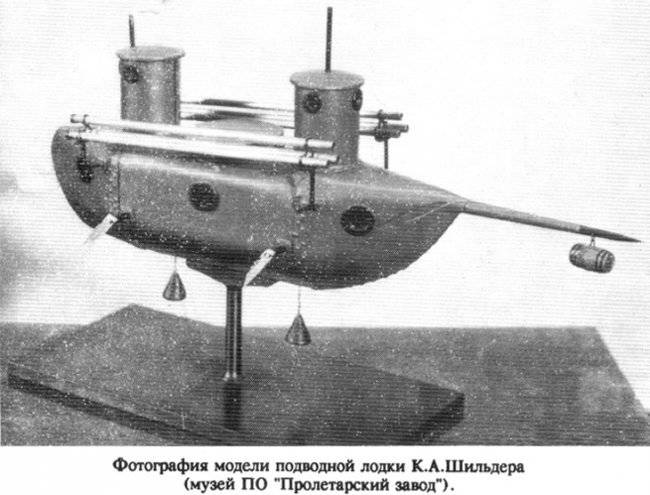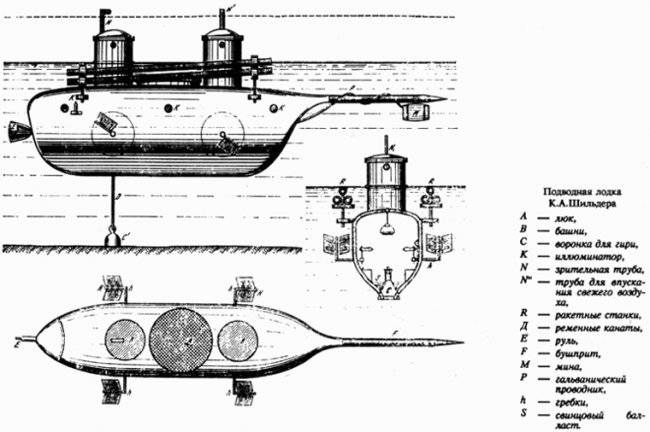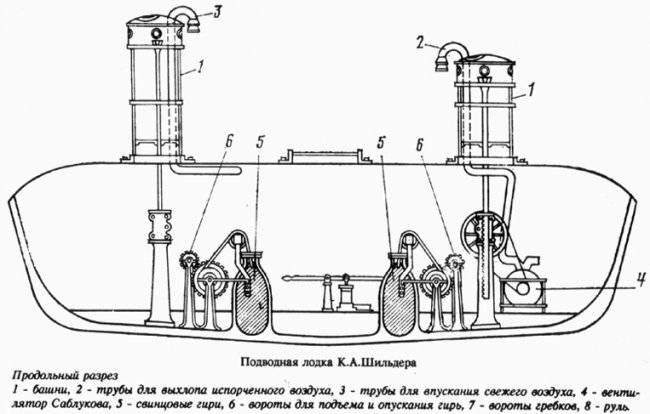Submarine K. A. Schilder
The hull withstand immersion to a depth of a little more than 10 meters. The strength of the submarine was achieved by its device and a set of its components, as well as the outer skin of the boiler iron with a thickness of 5 mm, which was connected by the method of riveting.

Characteristics of the submarine
The submarine hull outwardly looked like an ellipsoid body, slightly flattened laterally, with dimensions of 6 x 1,5 x 1,8 meters. Submarine displacement - 16,4 t; depth range was 12 m. The crew of the submarine - 13 sailors. The boat began to move with the start of the work of the rowers, who worked with two pairs of rowing devices, known as the “duck paw”. During forward movement, the strokes were folded, and on the reverse movement they opened, forming an emphasis. Each such device was set in motion by swinging the drive bracket from the internal cavity of the submarine.
Structurally, the drive brackets were made in such a way as to not only allow the submarine to move progressively, but also to lift and lower it.
Submarine ascent and dive
The system of raising and lowering the boat consisted of a water ballast tank and two anchors, each weighing about 1300 kg. The access hatches were equipped with cylindrical towers with a height of about 1. The novelty is considered to be an “optical” tube - a prototype of the current periscope, which the inventor manufactured using the concept of a horoscope by MV Lomonosov. The survey of the sea surface was carried out precisely with the help of this "optical" tube.
Submarine could stand motionless in the submerged state with discarded anchors. The speed planned in the project was small - a little more than 2 km. \ H, the real dynamic test was 0,7 km \ h. A removable sail mast was prepared for movement on the sea surface. For longer transitions provided for the integration of submarines in a kind of floating transport using a steam engine as an engine.
This submarine was equipped with electric, as well as primitive rocket projectiles, the launch of which was carried out with two three-pipe installations installed on each board. This combat floating craft could fire missile volleys from all positions.

Sea trials
Submarine design Schilder with a team of 8 people (senior - midshipman Shmelev) 29 August 1834, conducted a test on the dynamic characteristics of the boat. The submarine made submerged maneuvers, made planned stops. The designer received additional allocations for the design of a new underwater vessel.
Schilder's second submarine
Schilder's second submarine turned out to be somewhat smaller. It was an iron vessel that had a cylindrical shape with a pointed nose, which ended with an elongated bowsprit, into which a built-in harpoon with a mine was inserted. The principle of action was as follows, approaching the ship, the boat pierced the ship’s bowsprit and, leaving the mine mechanism inside the ship, retreated to a safe distance. After that, with the help of an electric igniter, the ammunition was exploded; electricity was supplied to the ammunition by wires from the onboard batteries of the boat. The submarine armament, except for the mine charge, consisted of 6 missile launchers in the form of tubes. The submarine could make volleys with rocket launchers of any position, either surface or submarine. Marine testing of the second project of Schilder Submarine took place on July 24 1838 g on the roads of Kronstadt, which was marked by the undermining of the ship's layout. The main problem of the Schilder submarine was the low speed of movement in the aquatic environment - the entire 0,3 node (600 meters per hour). The engine of the boat, based on the work of human muscles, could not develop great speed. Requires the use of submarines more powerful engines. During the period of 6-year tests of the Schilder submarine, good work was done on the use of the submarine artillery missile systems and the mining of water transport.

Schilder's third submarine
The result of these tests was also the allocation of funds by the state to continue the tests. As a result, a third submarine appeared, on which Sablukov's “water run” was tested - a jet propulsion unit driven by a manual hydraulic pump. The speed of the submarine in the aquatic environment was also low
Other inventions of K.A. Schilder
K.A. Schilder was the first among the designers to consider the possibility of using the movement of the ship in the submarine using electricity. This idea appeared to the designer after B. S. Jacobi’s experiments with an electromagnetic boat on the Neva in 1838. His arguments were K.A. Schilder outlined in a letter to the Minister of War of the Russian Empire.
Given the small distance to the target, K.A. Schilder invented a special pontoon-type swimming craft, armed, capable of being delivered to the cluster of enemy ships. According to the drawings of K.A. Schilder, the Russian military department manufactured the 2 “semi-underwater” ship with steam engines, which had a missile on board weapon and artillery. One of them, made of iron, is able to approach targets with a speed of 5 - 6 nodes, putting only a chimney on the water surface.
Conclusion
An interesting fact is that K.A. Schilder was the first to develop tactics for the use of submarines in the defense operations of fortresses in coastal areas, including use with pontoons and "semi-submarine" ships.
To study all the innovations and rational proposals, as well as the inventions of K.A. Schilder in military and naval affairs in 1840 was organized by the “Committee of submarines” from among the staff of the engineering and naval department of the Russian Empire.
The series is dedicated stories underwater shipbuilding and based on unique archival materials. 2006 year. Movie 1. "The Hidden Ship" (1710-1900) The prototype of a submarine was built in Russia by Efim Nikonov in 1724-1727. His idea was continued in the work of Russian engineers: S. Romodanovsky, K. Charnovsky (Chernovsky), K. Schilder.
Information